
28 minute read
FUEL
42 STUDENT HEALTH GUIDE FUEL
An active lifestyle and a healthy diet are key to a happy life and a great physique…
What you put into your body plays a huge part in your outward appearance, your mood, your mental health and how active you are. If you eat and drink well, you’ll be alert, focused and bursting with energy.
Getting the balance right Forget faddy diets that ban certain foods, such as ‘no carbs before Marbs’ and Beyoncé’s maple-syrup diet. They may show results initially, but they’re not achievable in the long term. Instead, go for a healthy, balanced diet and reap these benefits…
Control weight Variety is the spice of life, and a balanced diet certainly helps maintain a healthy weight. Eat five portions of fruit and vegetables a day – they’re lowcal but high in nutrients.
Combat diseases Eating a good range of vitamin and mineral-packed foods helps prevent certain health conditions – such as heart disease and strokes – and also maintains your cholesterol and blood pressure levels.
Boost energy By eating the right food in the right amounts, you’ll have more energy to exercise. This improves muscle strength, creates a toned physique and improves your endurance.
Relationship between diet and mental health Whilst research is still being conducted, it’s heartening to hear that nearly two thirds of people who don’t report mental health problems eat fresh fruit and vegetables every day, compared to less than half of those with mental health issues. Whilst a change in diet is unlikely to cure mental health issues entirely, it’s certainly likely to have a positive effect.
CHECK THE LABEL ON PACKAGED FOODS Check the traffic light system means neither high nor low, but when selecting packaged take care with lots of red, as foods. The more green on the these often contain the most label, the healthier it is. Amber sugar and fat.
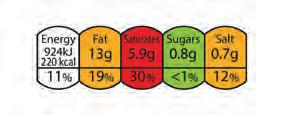
For more tips on how to tweak what’s on your plate to feel great, head to page 45.
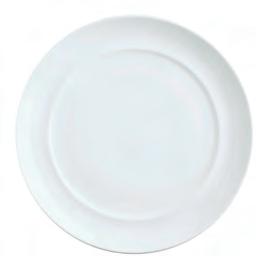
THE BEST FUEL APPS
These apps will help you maintain a balanced, healthy diet, and they’re all available for free:

MyFitnessPal (iOs and Android): Track your daily calorie intake by scrolling through the database to see what you’re eating and when.
Meal Planner Pal (iOs and Android): Organise your healthy eating recipes and the app will
THE FOOD GROUPS
Before embarking on a healthy, balanced diet, it’s useful to know your food groups:
Carbohydrates Found in pasta, cereals and potatoes, carbs have a bad reputation, but they’re crucial for energy.
Fats Not all fats are the same. Unsaturated ‘good’ fats found in oils, nuts and fish are great for your hair, skin and satiety, while saturated ‘bad’ fats, like those lurking in processed foods, can clog up the arteries.
Protein
Found in meat, poultry, dairy, fish and pulses, protein is important for muscle repair, particularly after exercising. MINERALS & VITAMINS
Minerals
These help us release energy from food. Look for them in fruits, vegetables and fish.
Vitamins Lots of vitamins from fresh fruits and vegetables aid concentration and help maintain healthy bones, teeth and skin.
compile a shopping list of all the ingredients that you’ll need.
Carbodroid (Android): Set a daily goal for water intake and chart your progress.
MAINTAINING A BALANCED DIET It’s easy to choose a salad over a burger for lunch and congratulate yourself. But how do you keep up healthy eating in the long term?
First of all, let’s make it clear that a ‘balanced diet’ is just that – a balance. This means that some days you go for the salad, and others you opt for the burger and triple-cooked fries. A healthy, balanced diet is not about cutting out entire food groups – it’s about enjoying food and eating everything in moderation.
Sometimes when we’re trying to be healthy or lose weight, cutting out entire food groups of tasty treats might seem the only solution. But undereating can be just as dangerous as overeating, and it can cause
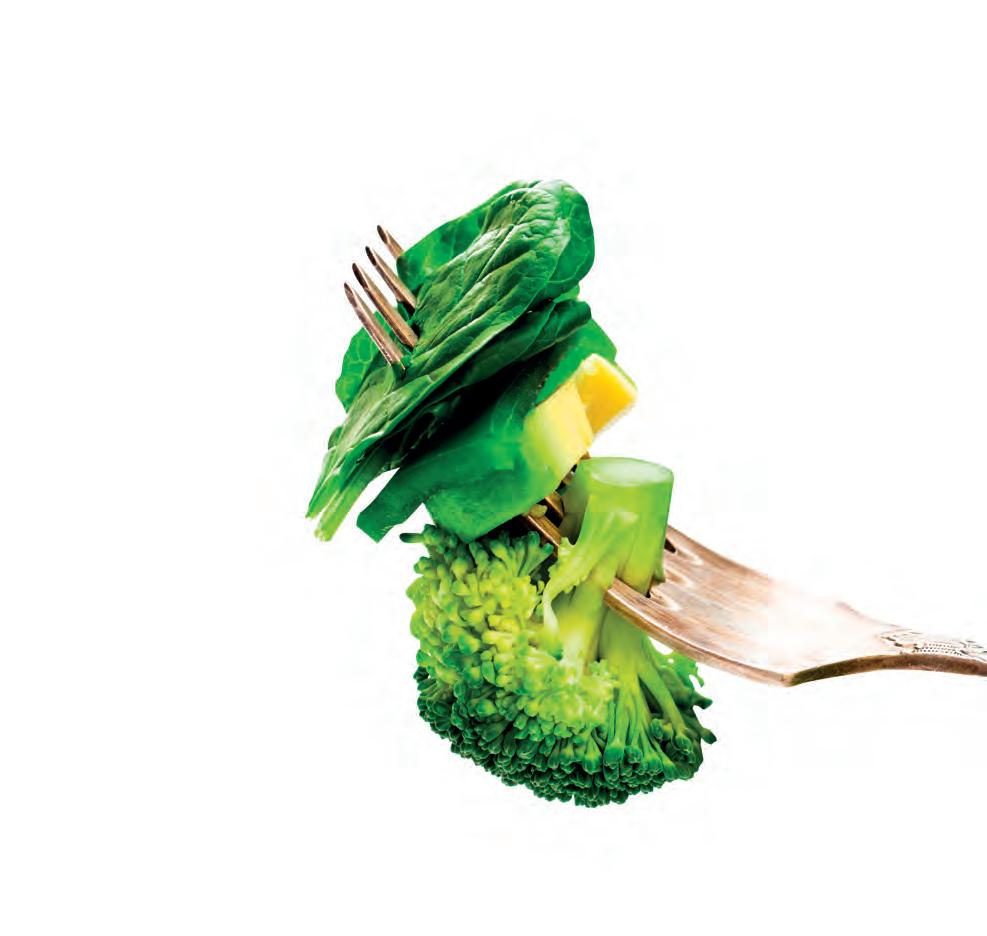
the body to go into starvation mode and retain fat, as well as make you feel rubbish. Cutting out all of the foods you love is also bad news, as when you do let yourself have them again, you might fall off the wagon and overeat…
The table below shows how many calories you should consume (on average) per day to maintain your current weight, but if you’re really active, you may need more. If you eat less than your recommended daily amount, over time you’ll lose weight; if you eat more, you’ll gain weight.
MALE 10,500kJ (2,500 calories) FEMALE 8,400kJ (2,000 calories)
GETTING THE RIGHT CALORIES
Just because you should aim to consume your recommended intake of calories every day, that doesn’t necessarily give you the green light to eat all of those calories in ice cream or cookies. Instead, your calorie intake needs to be varied across the food groups. Use the Eatwell Guide to help get balance of a healthier and more sustainable diet: FRUIT & VEGETABLES
Eat at least five portions of a variety of fruit and vegetables every day Eat beans and pulses, and two portions of sustainably sourced fish per week, one of which is oily (if you’re vegetarian, go for tofu cooked in olive oil). Eat less red and processed meat

JUNK FOOD
Eat less often and in small amounts Choose lower fat and lower sugar options
STARCHY CARBS Choose wholegrain or higher fibre versions with less added fat, salt and

PROTEINS

DAIRY & ALTERNATIVES
sugar OIL & SPREADS
Choose unsaturated oils and use in small amounts
SCHEDULING MEALS
One of the biggest obstacles to healthy eating is not planning ahead. Scheduling is a great habit to get into. When you’re starving but you have no time to prepare a dish, it’s all too easy to grab fast food, which are bad for your body and your bank balance. Check out our guide for what to eat and how to keep on track:
BREAKFAST
When you wake up, you probably haven’t eaten since bars or crisps. Stock up on
the previous evening, so it’s likely your body needs food to get going. Get into a morning routine - remember to eat breakfast and allow yourself enough time for it. It doesn’t have to be a huge meal – just a small bowl of porridge or a fresh fruit smoothie will satisfy your hunger, rev up your metabolism and offer enough energy to get through the
SNACKS
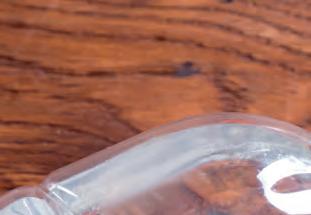
Contrary to popular belief, it’s fine to snack, as long as you’re eating the right foods most of the time. Nuts, berries, seeds, fruits and oatcakes are wholesome, healthy snacks that will offer you all the right nutrients and energy without the hidden sugars and fats that are often found in cereal morning.
snacks like these, so that when hunger strikes, you don’t end up reaching for a chocolate bar every time.
If you’re following another form of diet or eating regime, do some research as to whether you need to consider supplements – either supplementary food or by way of vitamins – to maintain a healthy diet. TOP TIP
LUNCH DINNER
The healthiest way to do lunch Try to sit down to a proper is to pack your own. Taking meal in the evening and load a home-made meal to uni or up your plate with fresh work will save loads of money, vegetables. Be creative and try plus you can ensure that you’re new things. Why not browse eating healthily. Each YouTube for free recipe Sunday, prepare ideas? Consider all five of your weekday lunches, so that you’ll have more time (and less stress!) on weekday mornings. Forgetful or disorganised? Take 10 minutes every week to write down on a piece of paper exactly what you aim to eat for breakfast, lunch and dinner each day. Use this as a shopping list to keep you focussed in the aisles. TOP TIP cooking more than you need, so that you can box up the leftovers for lunch or dinner the next day.
A little bit of meal prep will pay off hugely when it comes to your waistline – and your wallet…


THE TRUTH ABOUT BREAKFAST
The most important meal of the day is breakfast. We’ve heard that once or twice (or a million times) before, but is it true? Here are some answers to the recurring breakfast questions…
DOES BREAKFAST KICK-START YOUR METABOLISM?

When you break the overnight fast by eating breakfast, you trigger the thermogenesis process and stimulate your metabolism. Eating breakfast also kick-starts our digestive system, which helps our body regulate blood sugar. So, yes, breakfast does get your body ‘going’.
WILL SKIPPING BREAKFAST MAKE YOU GAIN WEIGHT?
In a study, doctors found that while subjects who ate breakfast didn’t lose weight when compared with those who skipped breakfast, eating breakfast did encourage them to be more physically active and eat less throughout the day. This is probably because eating a well-balanced breakfast of slow-releasing carbs and some protein – say, wholemeal toast with a boiled egg – helps to maintain blood sugar levels, giving you steady energy to work out with. So, it’s not a case of whether skipping breakfast will make you gain weight, but will eating breakfast make you more active?
Whilst skipping breakfast may not be as disastrous as our parents made us believe, it’s probably a good idea to always eat some food after you wake. It doesn’t have to be a full continental breakfast – something quick and light, like a banana with peanut butter will provide enough fuel to power you through the morning. And remember to always eat breakfast before important events such as job interviews or exams. THE VERDICT
THE TRUTH ABOUT BREAKFAST
60-SECOND
BREAKFASTS As much as we would all like to start the day with eggs florentine or a spinach frittata, who really has the time? So, for those days when you wake up with only minutes to get to your lecture, grab one of these 60-second breakfasts…

Banana Full of fibre and potassium, and good for on the go.
SHOULD YOU EXERCISE FIRST THING IN THE MORNING ON AN EMPTY STOMACH?
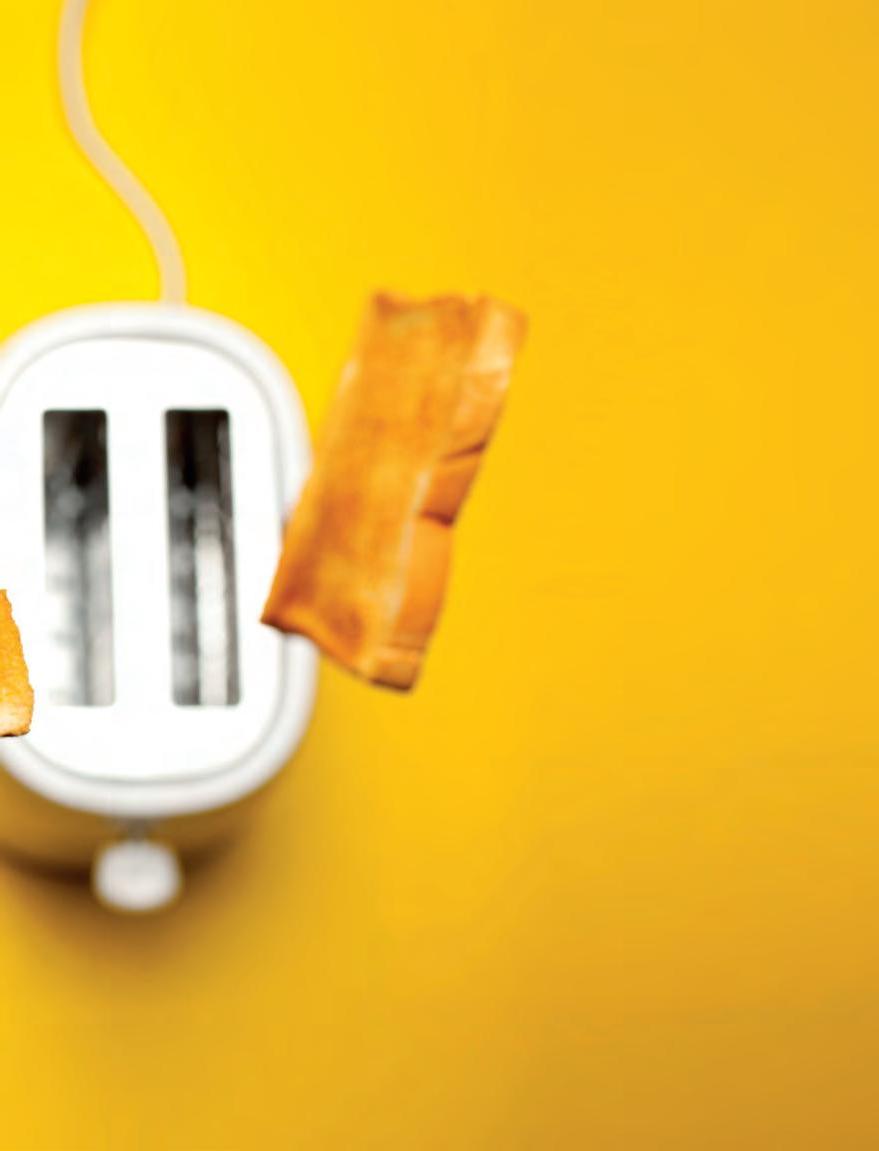
There’s complicated science behind the answer to this question. In short, it depends on what you’re trying to achieve – if you want to lose fat, this can be achieved by fasted cardio (say, going for a run on an empty stomach). However, if you want to lose fat and maintain muscle, good-quality fuel is required. Either way, if you’re new to exercise or suffer with low blood sugar, always eat something before you exercise.
Wholegrain cereal and milk Great source of fibre and dairy. Swap for almond or soy milk to go lactose-free.
Toast Possibly not quite 60 seconds but not far off. Add peanut butter for a boost of healthy fat and protein.
Yoghurt and fruit Throw some berries or nuts in your yoghurt for a healthy, fruity twist.
Orange juice and a handful of nuts Great for your Vitamin C fix, while the healthy fats and protein provide slowreleasing energy.

Cereal bar Not necessarily the cheap or healthy option but better than nothing (especially if you go for the proteinpacked ones)!
STAY HYDRATED DRINK UP!
What you drink, much like what you eat, can make you feel amazing or “ugh”. Check out our guide to the pros and cons of your favourites
What’s good What’s bad When should you drink it? Substitutes Water It has no calories and no sugar, so it’s the healthiest thing you can drink. Nothing! Drink it throughout the day to stay hydrated. Drink 1.6 to 2.0 litres throughout the day; more if it’s hot or after exercise. If the taste is too bland, add a slice of lemon or orange to add natural favour. Smoothies Most count toward your five-a-day fruit and veggie target. The naturally occurring sugars in fruit can damage your teeth. Smoothies are healthy in moderation – have no more than one per day. Grab noadded-sugar varieties, or make your own and add greens like kale. Tea & coffee Tea and coffee both contain antioxidants, which have cancer- fighting properties. These drinks are high in caffeine, so they make you feel temporarily alert, then drowsy. Drunk in moderation and early in the day, tea and coffee aren’t harmful. Try green or herbal teas, or de-caf coffee and tea to avoid a caffeine buzz or the ‘jitters’. Fizzy drinks Nothing! That’s why you should avoid them. High in sugar and low in nutrients, which can lead to weight gain. Don’t make this a daily habit. Have one only once in a while as a treat. Sip on sparkling water or soda water as a healthier alternative.
Energy drinks Useful for the replenishment of electrolytes during highenergy sporting activities.
These tend to be high in sugar and often contain artificial favours.
Consume sports drinks only during or after high- intensity exercise.
Get the low-cal version of the sports drink, or water it down with lots of ice. Find out how to make your own energy drink at tinyurl. com/zd8vk
HANGOVERCURES OK, so there is no ‘cure’, but there are a few things that make you feel better

If you drank one too many Jaeger bombs last night, chances are you feel rubbish. Not so awful if it’s the weekend, but bad news if you have uni or work the next day. Here are some top tips to bring you back to life quicker:
REHYDRATE Alcohol is a diuretic, which basically means it’s something that makes you pee more. If you lose more water than you replace, you become dehydrated (hence the banging headache). When you get in from your night out, drink a pint of water before going to bed. (Top marks for those who drink water between drinks on a night out!) If it’s all too late and the hang-over has arrived, drink loads of water now to quicken rehydration. GO BANANAS Because you pee more, you lose potassium, a mineral and electrolyte that plays a significant role in metabolism, water and chemical balance in the body, and a whole lot of other important stuff. Bananas have this in abundance, so reach for the fruit bowl to replace what you’ve lost.
A heavy night could mean that you’re still over the legal limit to drive the next morning. Don’t risk it. Use a singleuse breathalyser if you’re not sure. ARE YOU SAFE TO DRIVE? COFFEE & PARACETAMOL This is likely to be the hangover cure of choice for most, and there’s a good reason it’s been around forever. A caffeine burst will give you a much-needed energy boost and the paracetamol will ease a headache. Remember that this is only a temporary fix – if you want to feel good again, you need to replenish what you’ve lost: namely, water and potassium.
EAT WELL The thought of food may turn your stomach, but it’s really important to eat good, well-balanced meals to avoid feeling flaky. Soup is a great way of replacing lost water.
MONEY SAVING
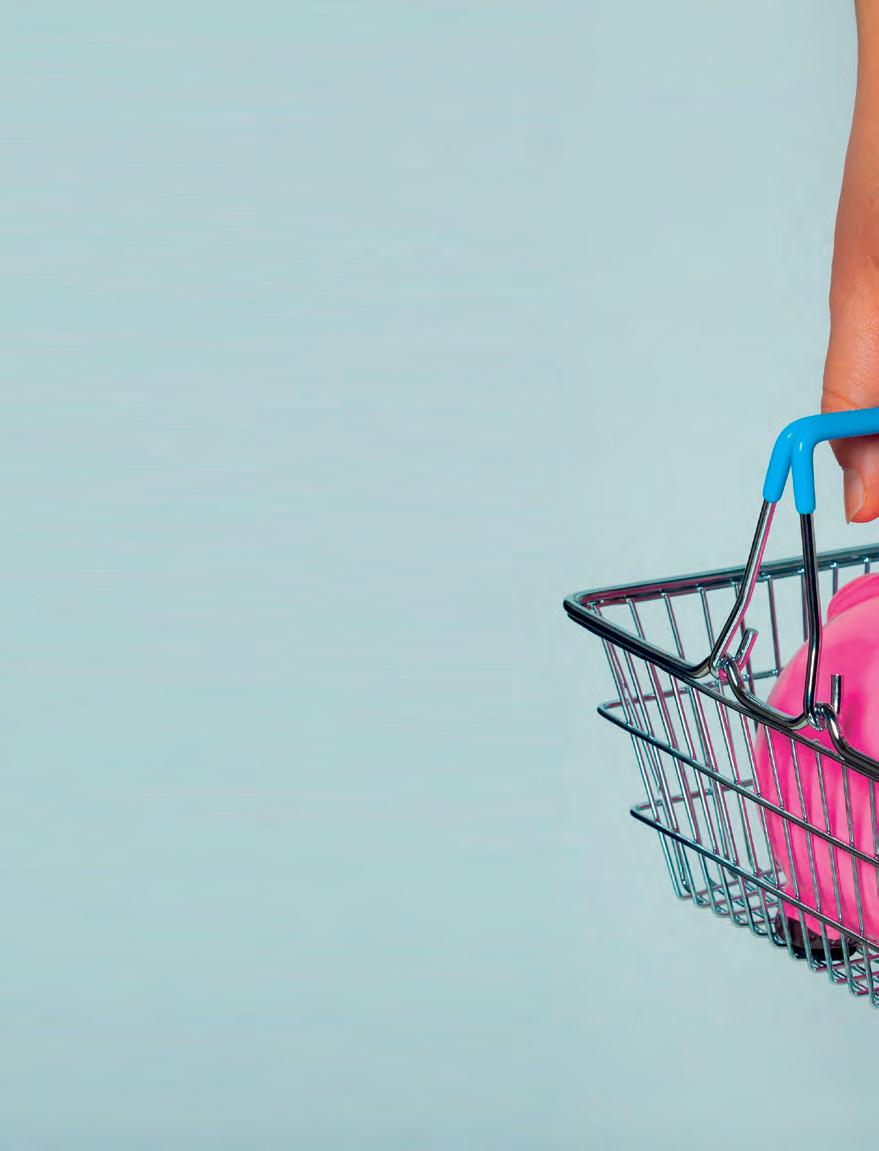
Most students don’t have a bottomless pit of money, so eating on the cheap is vital. The good news is you don’t have to break the bank to eat well. Plan ahead, reduce wastage and follow our top 12 tips to help ease the pain of the supermarket… 1 TAKE A LIST Take a list - Ever been to the supermarket without a list and bought random ingredients 4 STOCK UP Bulk buy 8 COMPARE PRICES Use online tools such as mysupermarket.co.uk to work out the cheapest place to with really close use-by dates? cheap, wholesome shop. Works well if you are Before you go, write a plan staples such as buying more expensive of what you want to eat for wholegrain rice and products such as alcohol each meal, each day to avoid pasta, chickpeas, or cleaning products. wastage. lentils and 2 BATCH COOK Batch cook – Cooking breakfast cereals. These items don’t perish and buying in larger quantities large meals and splitting them will save you up in to plastic containers to money per portion. store in the fridge will save you both time and money. ‘Leftovers’ work particularly well for packed lunches (see page 54). 5 BE LOYAL Sign up for loyalty cards to get points, money-off vouchers and offers.
6SHOP LATE Supermarkets tend to make their biggest reductions on fresh food just before the store closes. Time it right and you could grab a bargain. 3 CHEAPER CUTS If you eat meat or fish, 7 FREEZE FOOD Use the freezer to store food staples like vegetables and left-overs to reduce waste this can be the largest source and ensure you always have of cost in your shopping. Opt a good meal in stock. Store for cheaper fish and cuts of in single portion containers meats or go meat-free during so you defrost just the right the week. amount each time.
FUEL HACKS
9BAG FOR LIFE 5p or 10p for each bag, each time you shop? It will certainly mount.
Take your own bags to save your money and the environment.
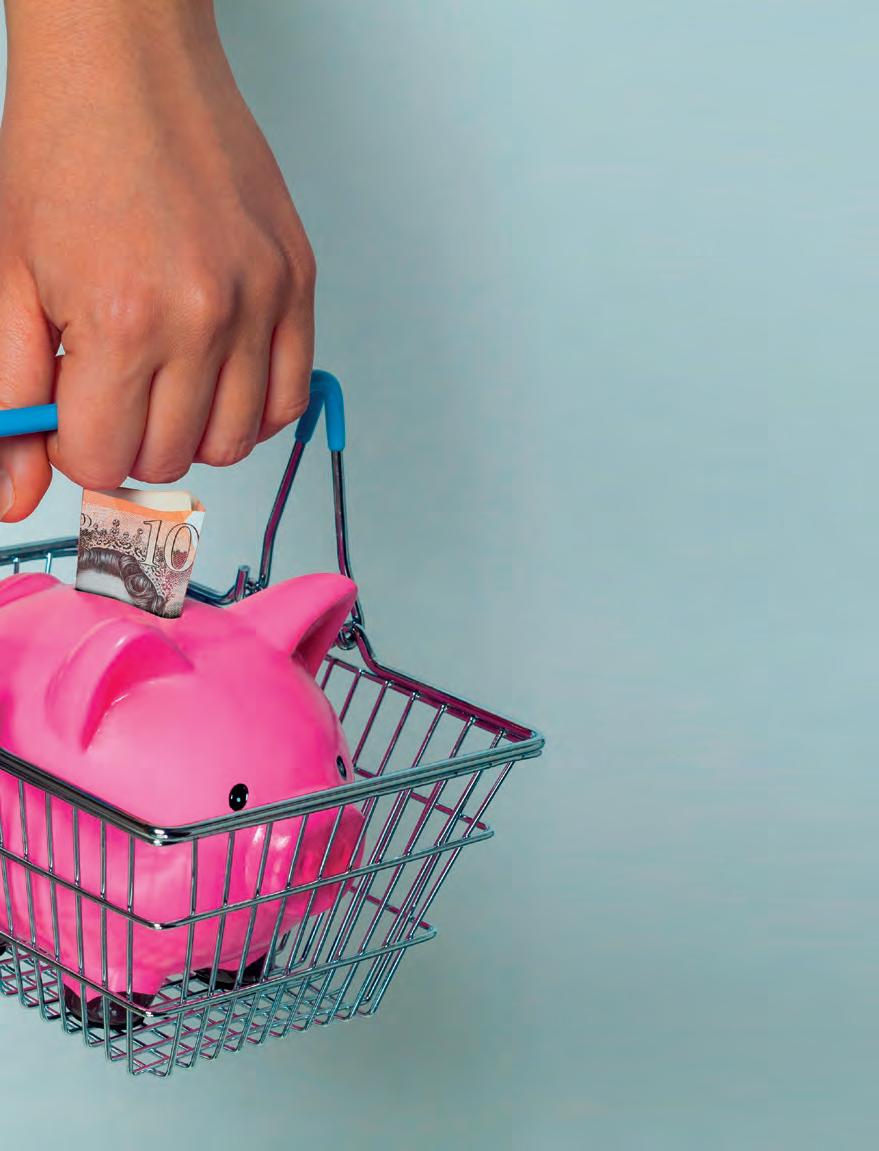
10 PROMOTIONS Don’t be fooled by ‘promotions’. Supermarkets are really clever at making you buy more than you want or need. Sometimes buy one get one free doesn’t work – particularly if its more expensive in the long-run and you might not use the second product anyway. 11 OWN BRAND Buy economy brands. Often, the cheapest supermarket range is just as good, if not better, than the well-known brands. Give the economy version a try – you can always switch back! 12 USE COUPONS Sign up to money saving sites to get coupons for free or discount items. Check your local newspapers and magazines, too!
Gone are the days of boring limp sandwiches and stale crisps – get creative with your packed lunches to create something tasty and cheap… POWER UP YOUR PACKUP
When you were a kid, it was likely that packed lunches = sandwiches and crisps. And whilst there’s nothing wrong with this, there are now far more appetising ways to prepare lunch for on the go. Whether you’re saving money, catering for a dietary requirement or simply using up the leftovers in your fridge, use our guide to get creative:
Packed lunches can be really convenient if you have a dietary requirement or preference and aren’t sure if there’ll be suitable options where you’re going. TOP TIP
SALAD Throwing a salad together is a great way to use up leftovers in the fridge. Add chicken, ham, tuna, lentils, pulses or a hard-boiled egg, together with a simple dressing (balsamic vinegar, a squirt of lemon…) to add taste and variety.
COUSCOUS It’s quick to prepare and easy to mix with vegetables. Make a couple of days’ worth and store in the fridge.
PASTA Opt for wholegrain pasta and whip up a healthy sauce with tinned tomatoes for a wholesome alternative. OK, so if you really want sandwiches, mix them up with different types of bread (baguette or ciabatta, anyone?) and add crisp lettuce leaves to cheese, meat or fish for a balanced, healthy lunch. HOUMOUS A small container of houmous and some carrot sticks or wholegrain breadsticks is a great way to introduce healthy fats and vegetables to your lunchtime meal. VEGETARIAN OPTIONS Enjoy salads with lashings of nuts, cheese and avocado, or

SANDWICHES
any meat-free option.

VEGAN OPTIONS Create an awesome mezze of houmous, pitta, tabbouleh, olives and vegetable sticks to keep hunger at bay.
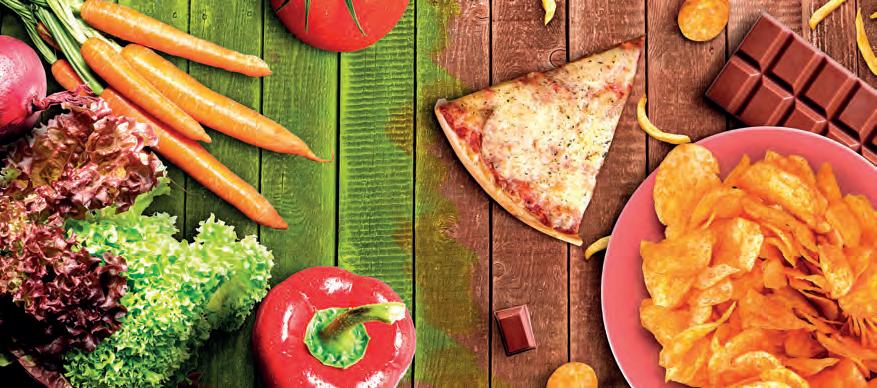
If your grandparents would instantly recognise what you’re eating, then it’s likely to be natural and unprocessed. TOP TIP
SAINTS, SINNERS & SUBSTITUTIONS
Sometimes ‘sugar free’ or ‘low in fat’ aren’t all they’re cracked up to be, so it pays to read the labels – or simply check out our guide… W ith so many choices on the supermarket shelves it can often sometimes it’s easier to opt for a familiar product even if it’s not the healthiest. consuming them on a daily basis, it might be worth considering a healthier, more be difficult to differentiate The ‘Sinners’ are fine in ‘Saintly’ alternative every now between products– so moderation, but if you’re and again:
SINNER
Cereal bars Often disguised as a healthy option, these bars are usually packed with sugar, refined grains and even chemicals.
Salad dressing Why opt for a fresh salad just to pour a processed salad dressing on it? Many are high in saturated fat, sugar, salt and hidden calories.
Processed fruit juices Lots of supermarket-bought fruit juices are full of artificial sweeteners, sugar and preservatives – and surprisingly little fruit.
‘Low fat’ or ‘sugar free’ alternatives In order to keep the taste, they often contain either a lot of added sugar or, in the case of ‘sugar free’, sweeteners (artificial alternative to sugar).
SUBSTITUTE FOR… SAINT
Nuts If you’re feeling peckish, have a handful of unsalted nuts, such as almonds and cashews. Nut allergy? Dried fruit is a great alternative.
Olive oil or balsamic vinegar If you can’t bear the taste of bare salad leaves, go for a splash of olive oil and balsamic vinegar to add flavour without any of the bad stuff.
‘Real’ fruit juices Grab some oranges and get juicing! Squeeze your own, or choose water flavoured with your favourite fruit for a speedier alternative.
Real food Real food doesn’t need a label. If you instantly recognise what you’re eating, then it’s likely to be unprocessed, natural and great for your body.
HEALTHY FAST FOOD If you’re planning to eat at one of the nation’s favourite fast food outlets, here are the healthier options to choose SWAP...
McDONALDS Double Sausage Egg McMuffin The golden arches are ■ 565 Kcal ■ 34g of fat usually bad news for Big Tasty your waistline, but with a few ■ 835 Kcal ■ 52g of fat neat substitutions, you can really cut back on the calories, Large Coca-Cola without sacrificing the taste. ■ 210 Kcal ■ 53g of sugar
KFC Mighty Bucket for One Everyone’s favourite ■ 1,275 Kcal ■ 66.7g of fat Colonel may do the Fillet Tower Burger best fried chicken – but ■ 620 Kcal ■ 26.2g of fat are you choosing the right things when eating at KFC? Milky Bar Krushems ■ 435 Kcal ■ 59.9g of sugar
SUBWAY Meatball Marinara
If it’s doughy ■ 460 Kcal ■ 18g of fat goodness you’re Spicy Italian Wrap after, Subway is king. ■ 820 Kcal■ 52g of fat
Make these small switches to dramatically reduce your Beef Chilli Soup calories and fat intake. ■ 350 Kcal ■ 22g of fat

FOR...
Cheese Toastie ■ 245Kcal ■ 10g of fat
Big Mac ■ 490 Kcal ■ 24g of fat
Large Diet Coke ■ 5 Kcal ■ 0g of sugar
Zinger Twisted Meal ■ 755 Kcal ■ 31.6g of fat
Zinger Burger ■ 450 Kcal ■ 17.5g of fat
Strawberry Sundae ■ 190 Kcal ■ 27.9g of sugar
Sweet Onion Chicken Teriyaki ■ 370 Kcal ■ 4.5g of fat
Black Forest Ham Wrap ■ 430 Kcal ■ 12g of fat
Tomato Basil Soup ■ 130 Kcal ■ 6g of fat
RECOMMENDED DAILY AMOUNTS:
MALE 2,500 Kcal ■ Fat 70g ■ Sugar 30g FEMALE 2,000 Kcal ■ Fat 70g ■ Sugar 30g
VITAMINS & SUPPLEMENTS

There are hundreds of different multi-vitamins and supplements on the market – but do we really need to fork out for them?
The diet of a uni student isn’t always fantastic. Whilst there’s nothing wrong with junk food, take-aways and alcohol in moderation, eating like this can mean that we don’t always get the right intake of vitamins, minerals and nutrients.
If we eat consciously – meaning, we actually think about what we’re consuming – and make a few healthy tweaks here and there, it’s very likely that we get what we need from our food. However, if you have dietary requirements or allergies, you may be falling short. In such cases, taking supplements is a great way to get what you need.
Vitamin/ mineral
Calcium
Vitamin D Vitamin A Vitamin C Zinc Omega-3 Why is it important? WHY IS IT IMPORTANT? The most common mineral in our bodies, calcium maintains healthy bones and teeth. But calcium alone is not enough – Vitamin D is needed to absorb it.
To absorb calcium more readily, we need to get enough Vitamin D. Also known as retinol, Vitamin A helps your body’s defence against infection and keeps your skin healthy. For healthy skin and to boost your immune system, make sure you have enough Vitamin C. Zinc is needed to maintain a healthy immune system and create new cells and enzymes. Beneficial for brain function, memory and vision. How can I improve my intake? HOW CAN I IMPROVE MY INTAKE? Adults need 700mg of calcium per day. Achieve this by consuming dairy products (think: milk and cheese), green vegetables (such as broccoli and cabbage), plus soya beans, nuts and tofu.
Short, daily periods of sun exposure help create Vitamin D, as does consuming oily fish like salmon and mackerel, eggs,
fortified spreads and breakfast cereals. Get this by consuming cheese, eggs, oily fish, milk and yoghurt. Most preformed Vitamin A comes from animal products. If
you’re vegan, consider a supplement. Plenty of citrus fruits (including orange juice), red and green peppers, strawberries, blackcurrants, broccoli and potatoes will give you the 40mg of
Vitamin C you need each day. Men need 9.5mg per day and women 7mg. Get this from meat, shellfish, dairy
foods, bread and cereals. Get this through eating fresh oily fish, like salmon and mackerel. The government recommends two portions per week. Don’t eat fish? Consider a supplement.
SUGAR Sugar gets a lot of bad press – here’s our guide giving you truth about sugar
With the new sugar tax legislation coming into effect, there is a lot of negative press about sugar - how bad is it really? Sugar itself isn’t terrible. In fact, ‘naturally occurring sugar’ is found in fruits, carbohydrates (such as rice and pasta) and even milk and we know these foods can be good for us. By contrast, ‘free sugar’ is added to many of our best loved foods to improve the flavour – from cookies to ketchup. These processed foods have increased calories, but little nutrition, meaning we often eat more calories than is needed. A high sugar intake causes our blood sugar levels to rise quickly, and then crash. This leads to fatigue and cravings for more sugary foods – and so the cycle continues.

How much is ‘too much’? The World Health Organisation suggests adults should consume no more than 5% of their daily calorie intake of foods containing ‘free sugar’ which is roughly seven sugar cubes or 30g. Unless you are very active, anything over this is unlikely to be a healthy choice.
So, should I eliminate all sugar from my diet? Not necessarily. Whilst some people strive for sugar-free diets (in respect of ‘free sugars’, not ‘naturally occurring sugars’), in reality it would be nearly impossible to achieve

this. It would mean never eating out or enjoying any sweet treats at all. It’s perfectly OK to consume sugar in moderation. Depriving yourself from foods you love – whether it be cake, chocolate or a sugar in your tea – is no fun and you put yourself more at risk of falling off the wagon and binging.
What are the effects of consuming too much? Consuming too much sugar can lead to an increase in weight and over time, other medical conditions such as diabetes and heart disease.
How can I tell which foods have sugar in? Read the labels. If the food doesn’t have a label – fruit, vegetables, rice, pasta – then you will know any sugar is ‘naturally occurring’. You may be surprised what food manufacturers sneak sugar into – bread, sauces, convenience meals and even soup – all to make the food taste better. It doesn’t mean you shouldn’t eat these things, but it’s good to be aware of what is in your food. Brands are good at disguising sugar on labels, too. Over 60 different ingredients are synonyms for ‘sugar’ - from sucrose, dextrose and rice syrup.
TOP TIP There is no need to completely remove sugar from your diet. It is fine to eat your favourite sugary foods from time to time as part of a balanced diet.
5SMALL CHANGES TO DECREASE SUGAR INTAKE
CUT DOWN ON SUGAR IN YOUR TEA OR COFFEE
If you have a couple of spoonfuls in each drink, cut it down over time until you don’t need it any more. LIKE SUGAR ON YOUR CEREAL?
Go for honey instead. It will give you the sweet kick you want in a natural form.
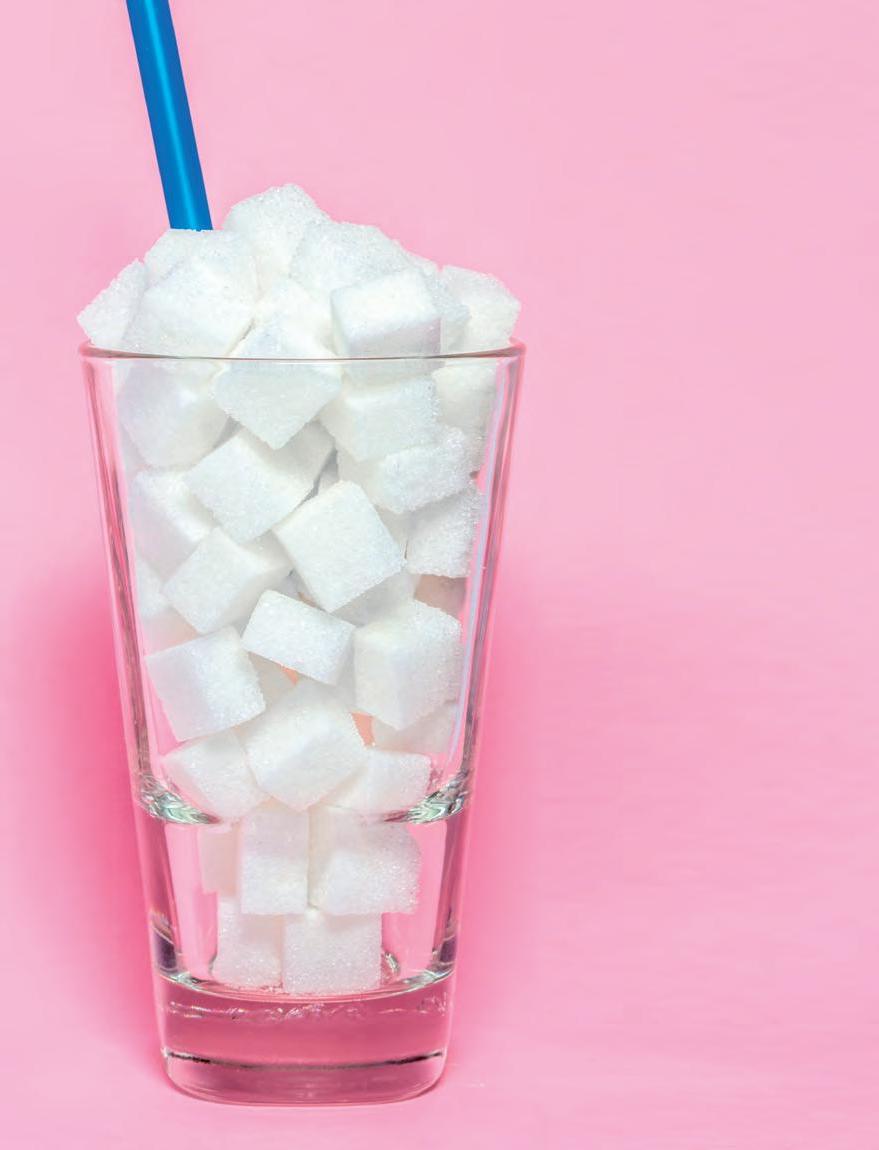
Often fat is replaced with sugar to keep the taste. If you love the ‘low fat’ option, simply cut the portion size. SMOOTHIES & FRUIT JUICES
Although the sugar may be
‘naturally occurring’, too much sugar can be bad news for your teeth. Use a straw to protect yourself further! SIMPLY DON’T BUY AS MANY SWEET TREATS
If you have them in your cupboard, you are more likely to eat them – opt for fruit instead when the urge to consume sugar strikes.
ALTERNATIVE Vegetarian, vegan, paleo, keto, Atkins… there are loads of specialised diets out there for us to follow. Whether it’s for personal or medical reasons, here’s what you need to know
Most specialised diets involve cutting something out. Whether its carbs, meat or dairy, these diets are safe so long as the diet you are following delivers the right ratio of carbs, proteins, fats, vitamins and minerals. There are lots of substitutions available to ensure that you get what you need.
VEGETARIAN
This is probably the most common specialist diet – most people know someone who is vegetarian. Vegetarians choose not to eat meat (and in many cases fish, too) for either dietary or personal reasons. Due to the fact that the protein derived from meat and fish is missing, vegetarians need to consider alternative sources, such as beans, lentils, dairy, tofu and eggs.

a
VEGAN
Anything that’s derived from animal products – meat, fish or dairy products – are off the menu.
Healthy vegans eat a good variety of fruits, vegetables, nuts and seeds to ensure a diet rich in essential vitamins. Vegans need to ensure that ensure they’re eating enough protein – try beans, lentils and tofu to get your fix.
PALEO
In a nutshell, if the caveman didn’t eat it, then neither do the paleos. This diet consists of meat, fish, fruit, vegetables, eggs, nut and seeds. Paleo followers can suffer from lack of energy due to the removal of processed carbs. Replace these with sweet potatoes and bananas between meals to keep those energy levels up. of
DIETS
If you are following an alternative diet, make sure that you are getting the vitamins and minerals required. Check out page 57 to ensure you are always getting what you need! TOP TIP
DIETING FACT OR FICTION
1Skipping carbs will help me lose weight
FICTION – Carbs are an incredibly important source of energy which we need to survive. Eaten in the right quantities and as part of a balanced diet, carbs won’t make you gain weight.
2Starving myself will make me thin
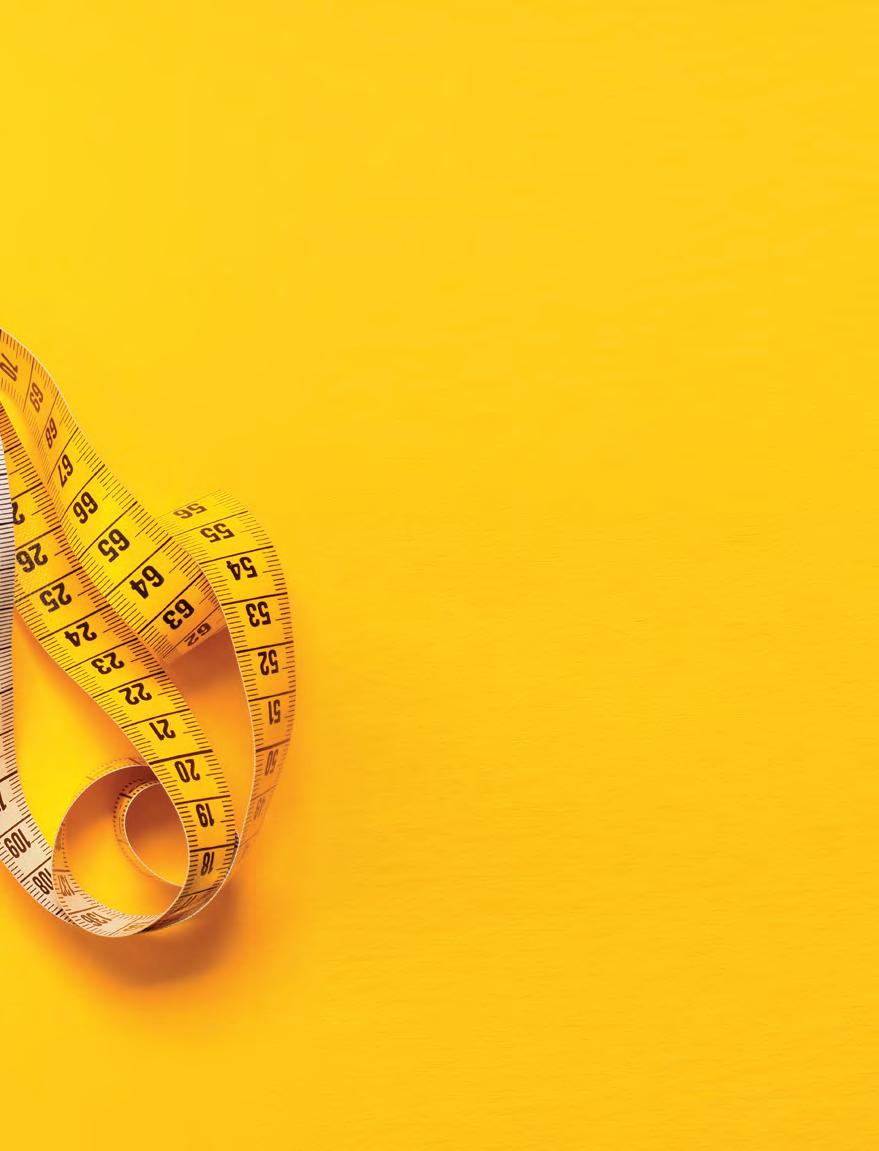
FICTION – Unlikely. It’s difficult to maintain a diet of nothing so you will either bounce back to where you were, or may even gain more
THE TRUTH
Maintaining a healthy weight for most is incredibly simple. As a basic rule, all you have to do is expend the same amount of calories that you consume. For example, if your body burns through 2,000 calories per day to stay alive:
■ If you eat 2,500 calories per day on average, over time your weight will increase pounds if you over-eat as a result. Your body will be low on energy and may cause you to crave high calories foods.
3Slimming pills are the answer
FICTION – Unless you have been prescribed something by your GP, don’t do it. You have no idea what you are ingesting when you purchased un-prescribed pills. The best case scenario is that they are a placebo and won’t work – that way it’s only money that you risk losing, not your health.
■ If you eat 1,800 calories per day on average, over time your weight will decrease
■ If you eat 2,300 calories per day on average but do daily exercise amounting to 300 calories, your weight will stay the same.
■ It’s simple maths. No diet pills or subscriptions to expensive groups required.



